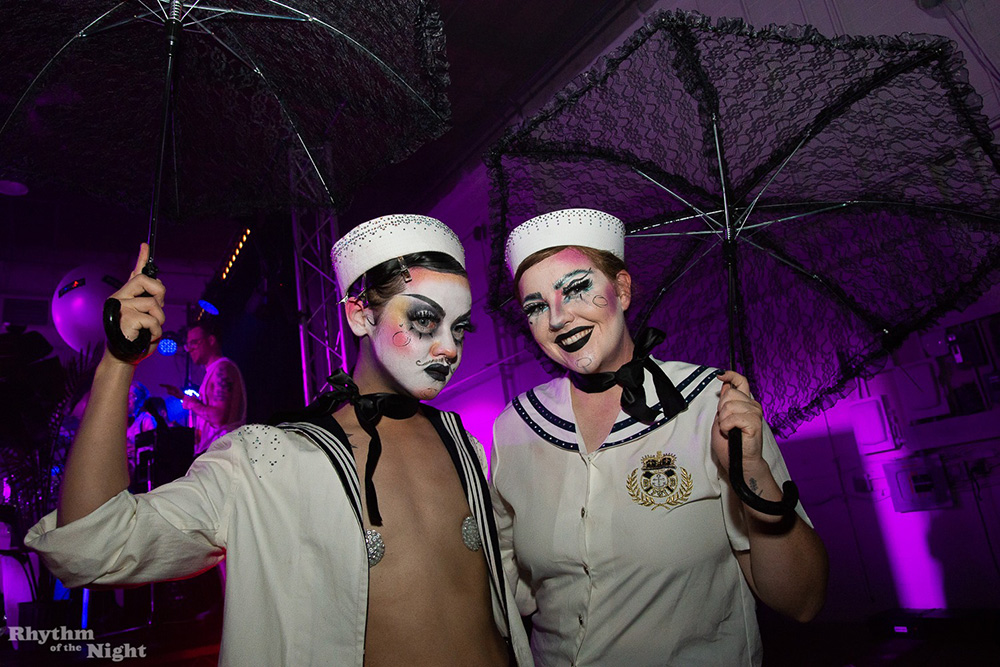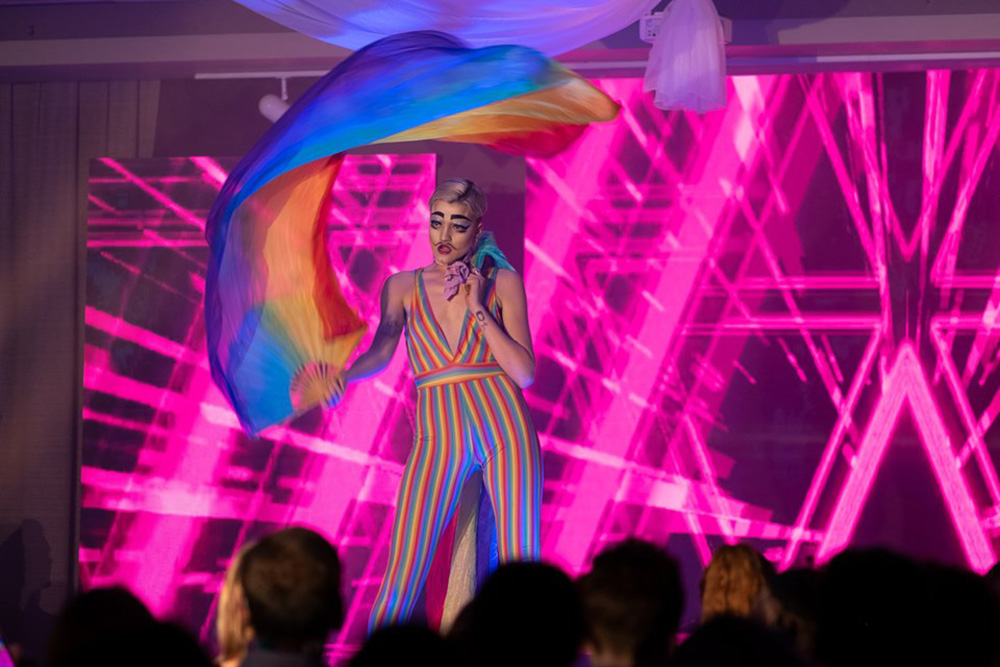While I’ve dipped my toes in raunchy burlesque, I’ve never done drag.
Wait, that’s a lie.
I once went to a drag-themed grad student party where I donned a vest and a tipped-back porkpie hat and did my best Tom Waits impression. Most of the partygoers weren’t queer, or at least they weren’t out yet. As soon as I got home, I wiped off my tea-leaf beard and repainted my lips with cherry bud lipstick. I wasn’t ready to surrender my hard-earned queer femininity.
Even though I put it on shakily, I could tell drag contained an alchemic power best wielded by the brazen. I didn’t know there was a new drag horizon where I wouldn’t have to choose between facial hair and cherry lipstick.
These days, everyone can watch drag queens compete for cash and fans from the comfort of their own living room, thanks to Netflix’s decision to add RuPaul’s Drag Race to its lineup.
But the latest drag innovation that you won’t catch on Netflix is the rise of Drag Things. Although many drag queens and kings are trans and non-binary people who play with gender in complex and surprising ways, Drag Things are performers who explode the gender spectrum.
On a recent Saturday, a mixture of queers — dykes, gay men, non-binary and trans folks — gathered to dance to the "Rhythm of the Night" at the Warehouse at Eastside Studios in Vancouver. The event, hot on the heels of the Dyke March and the Trans March, was organized in conjunction with Pride’s opening weekend.
The Saturday night crowd is less likely to attend Sunday’s parade with its corporate affiliations. They’re dancing to club house music from the 1980s and ’90s, as go-go dancers, voguers and drag performers command the evening’s limelight.
Around midnight, amidst a soup of sweaty bodies, local Drag Things Rose Butch and Grimm take the stage. Immediately, they resurrect the spirit of the ‘80s with a number set to Bananarama’s Britpop hit "Cruel Summer."
Dressed as glittery sailors, with fishnets and swooping eyeliner, the commanding duo struts and pouts in tandem, pulling out umbrellas and then large black fans — one reads “Cruel” and the other “Summer.” Together, they embody summer’s mercurial bouts of rain and heat that make the season unbearable.

The duo, with their exaggerated makeup, bedazzled sailor costumes and syncopated dance moves, make for a curious mix of cutting irony and pure sincerity. The combination is like an eerily sultry version of "Popeye the Sailor Man." As Drag Things, they fluidly embody archetypes rather than static genders. Basically, Rose Butch and Grimm’s performance asks if being a shimmering sailor weathering a bout of summertime sadness isn’t itself a gender identity.
Queer culture continues to invent a litany of new gender identities — feral femme, floral butch, non-binary forest witch, goth cat dad — to replace the conventional categories of male and female. Drag Things build further on this sense of play, elevating it to sparkly new heights.
Elizabeth Holliday, a.k.a. Dank Sinatra, draws from a background in musical theatre to create campy, gender-hazy numbers. The process of becoming a Drag Thing and crafting a swanky on-stage persona helped Holliday explore their own day-to-day gender identity.
“For me, being a Drag Thing means instead of presenting an image of strictly masculinity or femininity in my drag, I get to do both, either, all of the above,” says Holliday.
Holliday’s initial introduction to drag was at their first Pride in 2016, when they saw Rose Butch perform. They had an inkling that gender play was something they were interested in. Three years later, Holliday regularly performs as Dank Sinatra and identifies as non-binary both in and out of drag.
“As a non-binary performer, [being a Drag Thing] gives me the freedom to present gender the way I see it, and explore different sides of gender, rather than a binary image of cis-men-as-women or cis-women-as-men.”
Dank Sinatra’s performances have ranged from stripping to the ethereal wails of Kate Bush’s song "Wuthering Heights" while scaling the vertiginous rolling ladders of Vancouver’s Massy Books, to playing an enamoured Draco Malfoy passionately clutching a portrait of Harry Potter and lip-syncing to the Divinyls’ "I Touch Myself" for Storytelling with Drag Queens at Café Deux Soleils.
“I was still identifying as cisgender when I started doing drag. The ability to play around with my own gender and express that to people, have it taken up and celebrated, the space drag gave me to explore my identity and learn what feels good, allowed me to discover so much about myself,” says Holliday.
Tanya Boteju, a former drag performer and the author of Kings, Queens, and In-Betweens, a novel for young adults that features drag, has witnessed drag’s progress in the last decade and a half.
“When I was doing drag in Vancouver 15 years ago, the scene mostly included female-identified folks performing male drag, or male-identified folks performing female-drag, as far as I knew, anyway,” says Boteju. “Now, I’m seeing in both Vancouver and Victoria a lot more performers who may identify in many different ways performing a variety of genders or perhaps even something beyond gender — clowns, animals, objects!
“People exist beyond the binaries. Drag just amplifies that. Now we’re seeing Drag Things amplify the idea that gender is a construct and that so much more is possible.”
As contemporary drag expands our notions of gender, it’s also being welcomed into the mainstream. This summer marked the launch of Drag Camp For Kids, a pilot project in Vancouver where youth learn about and perform drag. The CBC documentary Drag Kids that premiered at Toronto’s Hot Docs festival this spring follows four pre-teen drag performers as they gear up for a large ensemble number in Montreal. The film follows the young performers, supported by their families and communities, as they explore and express gender through drag. It’s a heartening experience, despite some negative reaction to the film.
Boteju says she’s noticed that young people are embracing drag, which is reflected in her novel. It’s no longer a 19+ phenomenon.
“Even since I started writing the book — about three years ago — it seems like youth drag culture has really exploded. For instance, I’ve been really impressed with how many opportunities exist for younger folks interested in drag in Victoria, B.C., and I’m so lit up about it,” says Boteju.
But while introducing drag to mainstream audiences makes queer culture accessible to queer and trans youth, does its embrace as entertainment by straight adult audiences obscure the complexity and diversity of queer and trans lives? As drag goes mainstream, who gets left out?
“If you take all of the things drag does — screw with gender norms, allow for a vast array of self-expression, provides fun and political entertainment, grow diverse and inclusive communities — it seems to me these are all things we’d want to encourage for young people,” explains Boteju.
“A problem arises when mainstream culture welcomes the fun and campy aspects of drag (which are awesome and should be loved), but then misses the inherently political and socially significant aspects of drag.”
Mainstream audiences should learn from drag in “meaningful ways,” Boteju says.
“Meaningful ways to me means learning from the boundary-breaking that drag does and taking it into their lives — teaching their kids that gender norms are rubbish, understanding that person over there who kind of looks female but has a beard is perfect as they are, calling people in their lives out when those people are acting in homophobic or transphobic ways, honouring the role trans women of colour have played in the LGBTQ+ movement.”
Boteju explains that straight audiences who show up for the amusing spectacle of drag also have the responsibilities of “acknowledging the huge inequalities that still exist for queer folks and trying to make it better.”
I agree with Boteju and believe these responsibilities extend to queer community whenever we organize and create space. Our communities are steeped in off-kilter power dynamics — misogyny, racism, colonialism, classism, fatphobia, among others — that we dance around and into any time we gather. Learning from the boundary-breaking and radical spirit of drag, we need to continue to question who is and isn’t on stage and why.
While the integration of drag into mainstream culture signals progress for LGBTQ+ communities in terms of social acceptance, it also obscures drag’s more radical roots. When my straight friends tell me they’re watching RuPaul’s Drag Race, I want to ask “Where were you five years ago when I could barely find an illegal stream?!”
Also, I wonder if we let how we show ourselves be dependent on who is watching.
Sometimes I want to watch the camp and glamour of drag queens on TV, and other times I need to go to a local bar and watch spectacularly amateur Drag Things do bizarre acts that bring new desires into being.
The defiance inherent to drag inspires and comforts queer and trans audiences. Drag processes queer experiences with its absurd, inventive vernacular.
As long as queer and trans culture continue to mutate and evolve, drag exists as a funhouse mirror, reflecting and refracting lived realities and fabulous fantasies. ![]()
Read more: Gender + Sexuality
















Tyee Commenting Guidelines
Comments that violate guidelines risk being deleted, and violations may result in a temporary or permanent user ban. Maintain the spirit of good conversation to stay in the discussion.
*Please note The Tyee is not a forum for spreading misinformation about COVID-19, denying its existence or minimizing its risk to public health.
Do:
Do not: